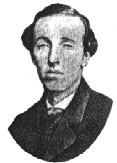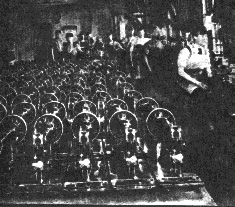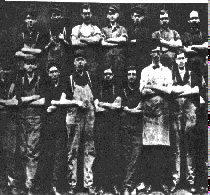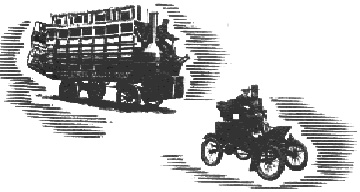A bit about White
Issue 62
ISMACS News

VINTAGE White sewing machines are today among the most commonly found models in the United States. They are robust, well-made, machines capable of sewing thick materials that many modern machines are incapable of handling.
In 1858, at the age of 22 the founder of the company, Thomas White began manufacturing New England-type sewing machines which he sold for $10 apiece. The first machines were manufactured at the small Wilkinson Machine Shop in Templeton, Massachusetts. White and a business partner pooled together $350 to start their company. Funds were so scare that each machine made had to be sold before Mr. White could afford to manufacture another. In 1866, sewing-machine production was moved to Cleveland, Ohio. And in 1876, the White Sewing Machine Company was incorporated.

The Wilkinson Machine Shop at Templeton, Massachusetts, where Thomas White constructed his first machine-a copy of the New England-type chain-stitch model. The first White sewing machine labelled as such was a vibrating-shuttle model introduced in 1876.
A vibrating-shuttle lock-stitch sewing machine was introduced in 1876. From the beginning, it was a very popular model, with a total of about 80,000 sold from 1876 through 1880. In 1882, the company was producing about 1,200 sewing machines a week and about 60,000 machines annually. This White model was described by a contemporary source as a machine of simple construction with a minimum number of parts, a good amount of space under the arm, featuring a feed on either side of the needle, and possessing a self-setting needle and a self-threading shuttle.
An improved version of the White vibrating shuttle sewing machine was introduced in the late 1880s. The tension device, now positioned on the sewing head, was adjusted by a thumb nut. The machine was also larger, possessing a longer bed and higher arm than its predecessor. It was replaced with an improved version in the 1890s which continued in production into the 1920s.
In the late 1890s the company's vibrating-shuttle model was supplemented with a new rotary model, known initially as the "White Family Rotary". It became the most popular White model and continued to be manufactured by the company in various incarnations into the 1950s.

In 1866, Thomas White moved his operation to Cleveland, Ohio. The city was chosen because of its strategic location-it was nearer to the majority of consumers and supplies of materials
In terms of quality, White sewing machines were consistently ranked as a close second to those manufactured by Singer. The company earned scores of awards for its machines at many expositions including the Cuban Exposition of 1881, the New England Fair of 1883, the Feria Exposition of 1889, the Southern Exposition of 1890, and the Texas Exposition. However, in 1889, the company won its most prestigious award-the Universelle Exposition medal in Paris.
In the late 1890s, the company diversified its operation and began manufacturing items such as roller skates, bicycles, kerosene lamps, lathes, and screw machines. In 1901, the company produced its first automobile. Thomas White, still president of the company, gave control of vehicle production to his three sons, Windsor, Rollin, and Walter.
When production requirements for the vehicles increased, a separate company was formed in 1906. Known as the White Motor Company, the three White sons continued production of the steam-engined vehicles. In 1909, the company introduced a gasoline-powered automobile. And in 1910, White Motor produced its first gasoline- powered truck.

A beautiful site to behold-hundreds of White vibrating shuttle machine heads, finished and ready to ship out
Like many other sewing-machine manufacturers, White manufactured and labeled many sewing machines for retailers. After acquiring the Domestic Sewing Machine Company of Buffalo, New York, in 1924, White continued manufacturing the Domestic-made Franklin sewing machines for Sears Roebuck & Co. Domestic became a fully-owned subsidiary of White. In 1926, under the leadership of company president A S Rodgers, the company was reorganised as the White Sewing Machine Corporation.
From the mid-1920s through 1950s, White was the main supplier (and by the early 1930s, was the sole supplier) of sewing machines to Sears Roebuck & Co. Models sold through Sears included the Minnesota, Franklin and Kenmore. They were basically White models labelled with the Sears company's brand names.
In the late 1920s, the company introduced the first-ever sewing machine with a flat crinkle finish. The mark-resistant paint was supposed to be easier on the operator's eyes because it did not give off glare and was also more resilient to wear than the traditional japanned finish. In place of decalcomania decorations, fancy scrollwork was cast into the head of the machine. This kind of "modern" finish became popular in the late 1920s and 1930s, and other manufacturers, including Singer and National, followed with their own crinkled-finished machines but without the cast decorations.

In 1889, the White Sewing Machine Company won the Universelle Exposition medal in Paris. This was its display stand
In 1940 a time capsule, called the Crypt of Civilization, was sealed and buried at Oglethorpe University. A crinkle-finished White Model 77 rotary sewing machine was one of the few physical items enclosed.
During the Second World War, the company ceased producing sewing machines in favour of manufacturing more badly needed material for the war effort. White was given the Army and Navy "E" award in recognition for its effort.
After the war, there was a severe shortage of sewing machines in the United States. Seizing the initiative, the company expanded its plant and capacity to manufacture machines. The company also introduced a number of new models including an automatic zig-zag machine based on German designs.

In 1918, White moved from its old plant on Canal Road, Cleveland, to E79th and St. Clair
However, the post-war period also saw the large-scale introduction of foreign-made sewing machines onto the American market, which included advanced European models capable of carrying out many functions that the typical American-made domestic-use sewing machine was incapable of achieving.

White sewing-machine factory employees pause from their daily routine to pose for a photograph, likely taken in the late 1890s or early 1900s
However, the most devastation to White and the other American companies was wrought by the dumping of cheap Japanese clones onto the market. American manufacturers could not compete with the low cost of Asian labour and by 1960 all American manufacturers of domestic sewing machines, save Singer, had either gone bankrupt or were absorbed by foreign companies including White which merged with the Norwegian-based Husqvarna Viking.

With business booming, the company moved its factory once again in 1924 to Main and Elm Streets, the centre of Cleveland's industrial area. The site would remain the premises of the White Sewing Machine Company until the early 1950s
Today, the most-easily found White sewing machines are the rotary models, which include the Models FR, 41, 43 and 77. Many are found in Sears livery and so are labelled either Kenmore, Minnesota or Franklin. The Model 8, a Singer Model 27 clone that had initially been manufactured by Domestic, is also found occasionally.
The older vibrating shuttle models, however, are somewhat more difficult to find in good condition.

Old White steam-powered truck and early automobile. Although the company initially only manufactured steam-powered vehicles, it later produced gasoline-powered models





